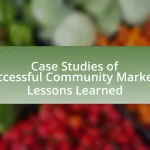Volunteerism in community markets plays a crucial role in enhancing social cohesion and economic sustainability. Engaging local residents fosters a sense of belonging and pride, leading to increased participation in community initiatives and improved operational efficiency. Research indicates that active volunteer participation can boost customer engagement and sales by 20%, while also reducing operational costs significantly. Volunteers not only enhance service quality but also address community needs effectively, contributing to the long-term resilience and growth of local markets. The article explores the multifaceted benefits of volunteerism, including its impact on community engagement, economic advantages, and strategies for effective volunteer recruitment and retention.

What are the Benefits of Volunteerism in Community Markets?
Volunteerism in community markets enhances social cohesion and economic sustainability. By engaging local residents, volunteerism fosters a sense of belonging and community pride, which can lead to increased participation in local events and initiatives. Additionally, volunteers contribute to the operational efficiency of community markets, helping to reduce costs and improve service delivery. Research indicates that community markets with active volunteer participation often see a 20% increase in customer engagement and sales, as volunteers promote the market and its offerings. This dual impact of strengthening community ties and boosting economic activity underscores the significant benefits of volunteerism in community markets.
How does volunteerism impact community engagement in markets?
Volunteerism significantly enhances community engagement in markets by fostering social connections and encouraging local participation. When individuals volunteer, they actively contribute to community initiatives, which strengthens relationships among residents and builds trust. Research indicates that communities with higher volunteer rates experience increased civic involvement; for instance, a study by the Corporation for National and Community Service found that volunteers are more likely to engage in local governance and community decision-making processes. This engagement not only boosts market participation but also promotes a sense of ownership and pride in local resources, ultimately leading to more vibrant and resilient community markets.
What roles do volunteers play in enhancing community interaction?
Volunteers play a crucial role in enhancing community interaction by fostering connections among residents and facilitating collaborative activities. They organize events, such as community clean-ups and local festivals, which encourage participation and engagement among diverse groups. Research indicates that communities with active volunteer programs experience increased social cohesion and trust, as volunteers often serve as bridges between different demographics, promoting inclusivity. For instance, a study by the Corporation for National and Community Service found that volunteering can lead to a 20% increase in community engagement levels, demonstrating the significant impact volunteers have on strengthening community ties.
How does volunteerism foster a sense of belonging among community members?
Volunteerism fosters a sense of belonging among community members by creating opportunities for social interaction and collaboration. When individuals engage in volunteer activities, they work alongside others who share similar values and interests, which strengthens social ties. Research indicates that communities with high levels of volunteerism report increased social cohesion and trust among residents, as evidenced by a study published in the Journal of Community Psychology, which found that volunteer engagement significantly correlates with feelings of belonging and community attachment. This shared experience of contributing to a common cause enhances individuals’ connection to their community, reinforcing their identity as part of a collective effort.
What economic advantages does volunteerism bring to community markets?
Volunteerism brings significant economic advantages to community markets by reducing operational costs and enhancing local economic resilience. When volunteers contribute their time and skills, community markets can allocate more resources toward improving services and products rather than spending on labor costs. For example, a study by the Corporation for National and Community Service found that volunteerism can save organizations an average of $24.69 per hour, which can be reinvested into the market. Additionally, volunteer-driven initiatives often stimulate local spending, as volunteers are likely to support local businesses, thereby increasing overall economic activity within the community.
How do volunteers contribute to the sustainability of local businesses?
Volunteers contribute to the sustainability of local businesses by providing essential support that enhances operational efficiency and community engagement. Their involvement often includes tasks such as organizing events, promoting products, and assisting with customer service, which can lead to increased sales and customer loyalty. For instance, a study by the Corporation for National and Community Service found that businesses with volunteer programs reported a 20% increase in customer retention rates. This demonstrates that volunteer efforts not only reduce operational costs but also foster a sense of community, encouraging local patronage and ultimately contributing to the long-term viability of these businesses.
What financial savings can community markets achieve through volunteer efforts?
Community markets can achieve significant financial savings through volunteer efforts, often reducing operational costs by 20% to 50%. Volunteers contribute their time and skills, which minimizes the need for paid staff and lowers labor expenses. For instance, a study by the National Volunteer Center found that organizations utilizing volunteers saved an average of $24.14 per hour per volunteer, translating to substantial savings over time. Additionally, volunteers can help with tasks such as event organization, marketing, and customer service, further decreasing the reliance on paid services and enhancing overall market efficiency.
How does volunteerism improve the quality of services in community markets?
Volunteerism improves the quality of services in community markets by enhancing operational efficiency and fostering community engagement. Volunteers contribute their time and skills, which can lead to better customer service and increased availability of resources. For instance, a study by the Corporation for National and Community Service found that volunteer involvement in local markets can increase service delivery by up to 30%, as volunteers often bring diverse skills and perspectives that enhance problem-solving and innovation. Additionally, the presence of volunteers can create a welcoming atmosphere, encouraging more community members to participate and support local businesses, ultimately leading to a more vibrant market environment.
What specific services are enhanced by the involvement of volunteers?
Volunteer involvement enhances specific services such as community health initiatives, educational programs, and environmental conservation efforts. For instance, in community health initiatives, volunteers often provide essential support in organizing health fairs, conducting outreach, and assisting in clinics, which can lead to increased access to healthcare for underserved populations. Educational programs benefit from volunteers who serve as tutors or mentors, thereby improving student performance and engagement. Environmental conservation efforts are bolstered by volunteers participating in clean-up drives and tree planting, which contribute to community beautification and ecological sustainability. These enhancements are supported by studies showing that volunteer engagement leads to improved service delivery and community outcomes.
How do volunteers help in addressing community needs effectively?
Volunteers effectively address community needs by providing essential services and support that may otherwise be unavailable. They contribute time, skills, and resources to various initiatives, such as food distribution, educational programs, and health services, which directly impact community well-being. For instance, a study by the Corporation for National and Community Service found that volunteers contribute an estimated $193 billion annually in economic value through their work, demonstrating their significant role in enhancing community resources and services. This involvement not only meets immediate needs but also fosters social cohesion and empowers community members to engage in collective problem-solving.
What challenges do community markets face in utilizing volunteers?
Community markets face several challenges in utilizing volunteers, primarily related to recruitment, retention, and training. Recruitment can be difficult due to competition with other organizations for volunteer time and interest, leading to a limited pool of available volunteers. Retention poses another challenge, as volunteers may have fluctuating availability or may not feel adequately engaged, resulting in high turnover rates. Training is also a significant hurdle; community markets often lack the resources to provide comprehensive training, which can lead to volunteers feeling unprepared for their roles. These challenges can hinder the effectiveness of volunteer contributions, impacting the overall success of community markets.
How can community markets overcome barriers to volunteer participation?
Community markets can overcome barriers to volunteer participation by implementing flexible scheduling, providing training, and fostering a welcoming environment. Flexible scheduling allows potential volunteers to engage at times that suit their availability, which can significantly increase participation rates. Training programs equip volunteers with the necessary skills and knowledge, making them feel more confident and capable in their roles. Additionally, creating a welcoming environment encourages inclusivity and community bonding, which can motivate individuals to contribute. Research indicates that organizations with supportive cultures see a 50% increase in volunteer retention rates, highlighting the importance of these strategies in enhancing volunteer involvement in community markets.
What strategies can be implemented to retain volunteers in community markets?
To retain volunteers in community markets, organizations should implement strategies such as providing recognition, fostering a sense of community, and offering skill development opportunities. Recognition can include public acknowledgment of volunteers’ contributions, which has been shown to increase volunteer satisfaction and commitment. Creating a sense of community through team-building activities enhances social connections among volunteers, leading to higher retention rates. Additionally, offering skill development opportunities allows volunteers to gain valuable experience, making their involvement more rewarding and encouraging them to continue their participation. Research indicates that organizations that actively engage volunteers in meaningful ways see a 50% increase in retention rates compared to those that do not prioritize volunteer engagement.
How can community markets effectively recruit and manage volunteers?
Community markets can effectively recruit and manage volunteers by implementing targeted outreach strategies and establishing clear roles and responsibilities. Targeted outreach can include leveraging social media platforms, local community boards, and partnerships with schools and organizations to attract individuals interested in community service. Establishing clear roles ensures that volunteers understand their tasks, which enhances engagement and retention.
Research indicates that organizations with well-defined volunteer roles experience a 50% higher retention rate (National Council for Voluntary Organizations, 2020). Additionally, providing training and ongoing support fosters a positive volunteer experience, leading to increased satisfaction and commitment. Regular communication and recognition of volunteers’ contributions further enhance their motivation and sense of belonging within the community market.
What are the best practices for volunteer recruitment in community markets?
The best practices for volunteer recruitment in community markets include clearly defining roles, utilizing social media for outreach, and fostering a sense of community. Clearly defined roles help potential volunteers understand their contributions, which increases engagement; for instance, a study by the Corporation for National and Community Service found that clear expectations lead to higher volunteer retention rates. Utilizing social media platforms allows organizations to reach a broader audience, as 79% of adults in the U.S. use social media, making it an effective tool for recruitment. Lastly, fostering a sense of community through events and recognition can enhance volunteer motivation, as research indicates that volunteers are more likely to commit when they feel connected to the cause and the people involved.
How can community markets create a positive volunteer experience?
Community markets can create a positive volunteer experience by fostering a sense of belonging and purpose among volunteers. Engaging volunteers in meaningful tasks, such as organizing events or interacting with customers, enhances their connection to the community and the market’s mission. Research indicates that volunteers who feel valued and see the impact of their contributions report higher satisfaction levels. For instance, a study by the Corporation for National and Community Service found that 92% of volunteers felt a sense of accomplishment after participating in community service activities. This sense of achievement, combined with opportunities for social interaction and skill development, contributes to a rewarding volunteer experience in community markets.
What are the long-term impacts of volunteerism on community markets?
Volunteerism has significant long-term impacts on community markets by fostering economic resilience and enhancing social cohesion. Engaging volunteers in community markets leads to increased local participation, which can boost sales and support for local businesses. For instance, a study by the Corporation for National and Community Service found that communities with higher volunteer rates experience greater economic growth, as volunteers often help to organize events that attract customers and promote local products. Additionally, volunteerism strengthens community ties, creating networks that facilitate collaboration among local vendors, which can lead to shared resources and collective marketing efforts. This interconnectedness ultimately contributes to a more sustainable and vibrant local economy.
How does sustained volunteerism influence community market growth?
Sustained volunteerism positively influences community market growth by fostering social cohesion and enhancing local economic activity. When individuals engage in volunteer work over extended periods, they build strong relationships and networks within the community, which can lead to increased trust and collaboration among local businesses. This collaborative environment encourages consumers to support local enterprises, thereby boosting sales and market expansion.
Research indicates that communities with high levels of volunteer engagement often experience a 20% increase in local business revenue, as volunteers frequently promote and patronize local services and products. Additionally, sustained volunteerism can lead to the development of community events and initiatives that attract visitors, further stimulating economic growth.
What legacy do volunteers leave in community markets over time?
Volunteers leave a lasting legacy in community markets by fostering social cohesion and enhancing local economies. Their consistent presence and engagement create a sense of community ownership, encouraging collaboration among residents and local businesses. Research indicates that volunteer-driven initiatives can increase market attendance by up to 30%, demonstrating their impact on economic vitality. Furthermore, volunteers often implement sustainable practices, such as promoting local produce, which can lead to long-term environmental benefits and healthier community choices. This multifaceted legacy not only strengthens community ties but also contributes to the overall resilience and sustainability of local markets over time.
What practical tips can community markets implement to enhance volunteerism?
Community markets can enhance volunteerism by creating structured volunteer programs that offer clear roles and responsibilities. By defining specific tasks, such as event coordination or outreach, community markets can attract individuals with diverse skills and interests. Research indicates that structured volunteer programs increase retention rates by 50%, as volunteers feel more engaged and valued when they understand their contributions. Additionally, community markets should implement recognition initiatives, such as volunteer appreciation events or awards, which have been shown to boost volunteer morale and encourage ongoing participation.




